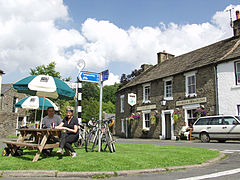This article includes a list of references, related reading, or external links, but its sources remain unclear because it lacks inline citations .(July 2013) |
| Garrigill | |
|---|---|
 Garrigill Village Green | |
| OS grid reference | NY745415 |
| Civil parish | |
| Unitary authority | |
| Ceremonial county | |
| Region | |
| Country | England |
| Sovereign state | United Kingdom |
| Post town | ALSTON |
| Postcode district | CA9 |
| Dialling code | 01434 |
| Police | Cumbria |
| Fire | Cumbria |
| Ambulance | North West |
| UK Parliament | |
Garrigill, Cumbria is a small village in the North Pennine region of the UK, situated on the banks and close to the source of the River South Tyne. Historically part of Cumberland, today it is within the Garrigill ward of the civil parish of Alston Moor within Westmorland and Furness. In 1870-72 the chapelry had a population of 1447. [1]
Contents
The village's name should not be confused with the hamlet of Galligill in the Nent valley, also within Alston Moor.
The village's former name is Garrigill-Gate and it was earlier known as Gerard's Gill. (Gill is a Norse word for a steep-sided valley).
At its peak Garrigill was home to 1,000 people, mainly employed in the lead mining industry; now its population numbers less than 200. While villagers were at one time mainly employed in local livestock farming, these days the population is fairly evenly divided between those in local employment, the self-employed and retirees. Garrigill Post Office is a traditional village store which has not changed substantially since the 1950s and is an attraction to many visitors, although at one time the village had four shops including a Co-op store.

For many years there has been one pub in the village, the 'George & Dragon', but this was closed from September 2009 to December 2010 and again from November 2013 to 3 April 2015. It subsequently closed again and re-opened on 25 August 2017. Before the mid-20th century there was a second pub, The Old Fox, next to the church.
The centre of the village is the green which the post office and George & Dragon overlook with the church and village hall nearby, but at either end of the village proper are the areas of Gatefoot and Gatehead, whilst on the village's outskirts are the settlements of Beldy, Crossgill, Loaning (pronounced Lonnin') Head and Ashgillside. There are two water pumps in the village, one on the green and one (which still works) by the bridge.

At Ashgillside and Beldy there are waterfalls namely Ashgill Force and Thortergill Force. Thortergill Force (formerly known to locals as Lady's Walk) was previously able to be accessed by the public, but access has now been closed by the current landowners.
The closest town is Alston, four miles away to the north.
The parish church of St John was for centuries a chapel of ease to St Augustine's at Alston but was promoted to full parish status in the 1980s. It is served by a team vicar based at Alston who also serves the churches at Nenthead, Knarsdale, Kirkhaugh and Lambley. There used to be several non-conformist chapels at or just outside Garrigill as well. Unlike most of the rest of Cumbria the parishes of Alston, Nenthead and Garrigill are within the Diocese of Newcastle not the Diocese of Carlisle.
At nearby Tynehead, now only a single house but once a thriving mining community, there was until the 1930s a primary school which was the highest school there has ever been in England. Garrigill's own school, located at Gatefoot on the Leadgate road, closed in the 1960s.

